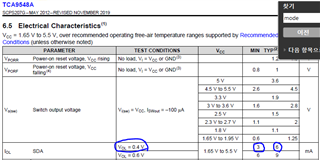Hello,
I have a discussion with customer about the whole confusion on VOL, IOL, and pull-up resistor value. Could you help understanding? Thanks!
Per my understanding, VOLmax 0.4V at IOLmin 3mA is specified in I2C bus spec, but TCA9548A would sink 6mA typically.
Then, the proper calculation for Rpu under 3.3Vcc is : Rpu.min = (3.3V - 0.4V) / 6mA = 3.23kohm ; IOL should not 3mA but 6mA. Is it correct?


For the equation (2), I'm referring to the attachment, I2C bus specification and user manual.

